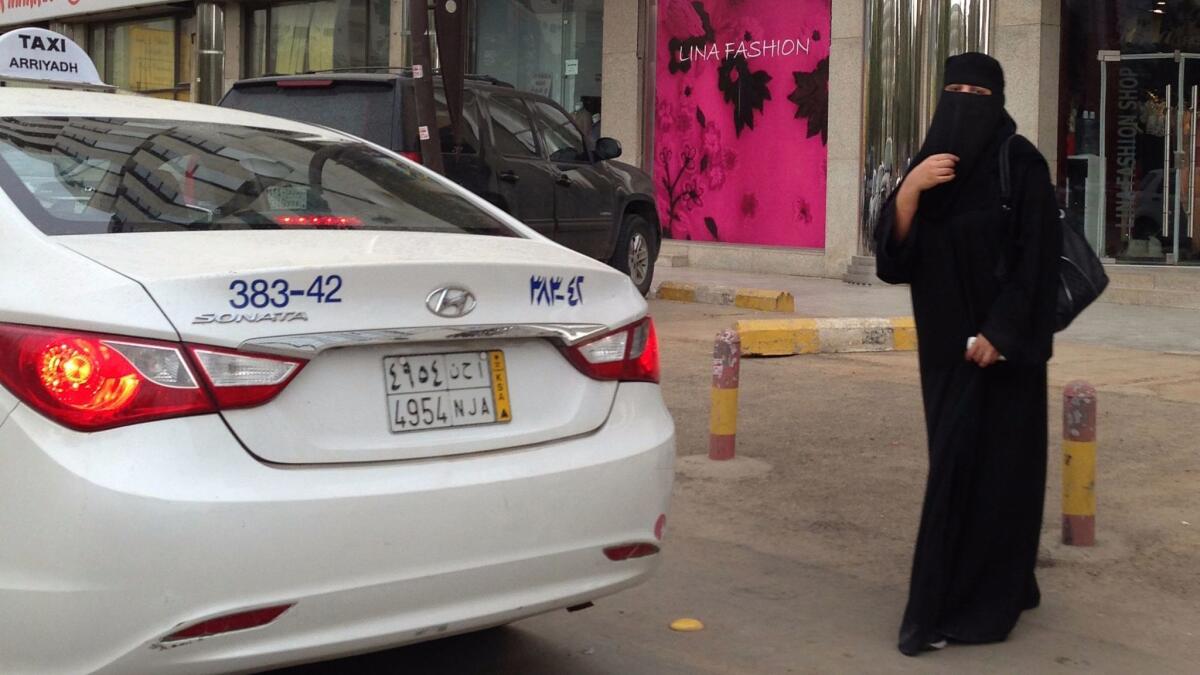Allowing women to drive is expected to boost Saudi Arabia’s economy

- Share via
Reporting from Beirut — “This is a statement with the names of the whores who had fallen prey to vice and corruption.”
So began a public list naming 47 Saudi women who, almost 27 years ago, circled around Saudi Arabia’s capital, Riyadh, in their cars. It was an act of defiance against a ban on female drivers that was no less absolute for being unofficial.
In the days that followed, the women were vilified by thousands of “Mutawaeen,” the Saudi religious police tasked with applying the country’s harsh interpretation of Sharia, or Islamic law. Many lost their friends, jobs and even their passports. For years later, their detainment and harassment by authorities became a matter of routine.
But earlier this week, a surprise announcement by Saudi King Salman bin Abdulaziz decreed that both men and women would be issued driving licenses starting in June. It was the end of an unwritten injunction that had long become a black mark on the kingdom’s image.
That it was a victory for women’s rights in Saudi Arabia is a given. But it was also another step in the plan, named “Vision 2030” by its architects, to lessen the country’s dependence on oil, keep more of its money within its borders and galvanize its people into joining the workforce.
“Women in Saudi Arabia have been advocating for the lifting of the ban in the 1990s and again in 2011 and 2013,” said Hala Dosari, a fellow at Harvard University’s Radcliffe Institute. “The timing had less to do with social pressure and more to do with the government recognizing that in order to accomplish its ambitious economic vision they had to make gradual adjustments.”
The ban had long been a financial and logistical obstacle to women becoming a part of the country’s economic life. With public transportation out of the question, many were forced to employ chauffeurs to go to work or run errands, said Mohammed Alyahya, a Saudi expert at the Atlantic Council, a think tank, in a phone interview Thursday.
A 2017 labor survey released by the Saudi General Authority for Statistics said about 1.3 million foreigners were hired as drivers, accounting for roughly 60% of foreign domestic workers in the country. But much of that money would never stay in Saudi Arabia.
“The remittances from drivers alone reach almost $4 billion. That’s a significant recurrent toll that’s leaving the Saudi economy on a yearly basis as a result of a government regulation barring women from driving,” said Alyahya.
Dima Jardaneh, head of Middle East and North Africa research at Standard Chartered in Dubai, said the figure could even be as high as $10 billion.
“This will boost disposable income of households, particularly for women, if they were covering the cost of transport themselves,” she said in a phone interview on Thursday. She added that even if the money were used for purchasing or maintaining vehicles, it would nevertheless increase “household consumption” in the country.
The ban was also one of many factors affecting women’s ability to join the workforce (experts estimate female labor participation in the Saudi economy is 17% to 22%). That number is especially low given the high percentage of women graduating from college in the country.
“Women had been pushed to enter the private sector as lawyers and engineers, but the biggest problem has been a logistical one, among both high-earning and low-income households,” said Alyahya.
But allowing women to drive, said Fawaz Gerges, a professor at the London School of Economics, “will not only save money but also simplify the lives of working Saudi women who must rely on either their male relatives or private hires transportation to get them to and from work.”
“It is a win-win policy for Saudi society and economy.”
With a female population of 14.8 million, experts see a market for driving schools for women. (One activist suggested such schools should be named after the 47 women arrested in 1990.) It will also require the hiring of additional female staff and trainers.
It would also make Saudi Arabia a more palatable location for highly skilled foreigners, said Alyahya.
“Much of the international talent in Saudi Arabia doesn’t want to live in the country. They prefer to live in Dubai and go back and forth,” he said.
The repeal was also a public relations coup for Saudi Arabia. Despite having spent billions of dollars on lobbying and PR firms in the U.S., the country was more often in the news for its role in the Sept. 11 terrorist attacks, its human rights record or the brutal war in Yemen.
In the run-up to the announcement, an event had been organized at the behest of the Saudi Embassy in Washington, while the country’s Foreign Ministry tweeted a cartoon of a smiling, veiled woman in the driver’s seat of a car.
“Saudi Arabia allows women to drive,” declared one caption in English. It was replicated in eight other languages.
David Ottaway, a Middle East fellow at the Wilson Center, a think tank based in Washington, said that although allowing women to drive is a step forward, there are other obstacles to female participation in the workplace.
“Women still have to work in segregated settings. Soon officials will also have to deal with the issue of what type of permission women will need to get in order to drive,” Ottaway said.
He said one barrier is the guardianship system requiring women to get permission from a male relative.
“You have this young prince who is trying to modernize the kingdom and so having women not drive is a contradiction of the 2030 vision he put forward, so you have to give him credit by taking on the religious establishment,” Ottaway said, referring to Crown Prince Mohammed bin Salman, the son of the monarch.
“If officials allow women to get their license on their own without permission then that is a big step in undermining the guardianship system, so we will have to wait and see how it’s applied.”
That sentiment was echoed by Philip Alston, the United Nations’ special rapporteur on extreme poverty and human rights.
“The royal decree issued by Saudi Arabia’s King Salman allowing women to drive cars is an enormous step forward. But it should now be complemented by a similar measure enabling women to work without requiring the approval of a male guardian,” Alston said.
“The end of the driving ban is of crucial importance for Vision 2030 because it unlocks the economic potential of women in the kingdom, especially those women living in poverty.”
Special correspondent Bulos reported from Beirut and Times staff writer Etehad from Los Angeles.
Twitter: @nabihbulos
More to Read
Sign up for Essential California
The most important California stories and recommendations in your inbox every morning.
You may occasionally receive promotional content from the Los Angeles Times.














